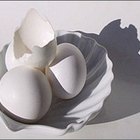
Scrambled eggs are a quintessential breakfast item in America. You can find them on almost every diner and cafe menu. According to the U.S. Department of Agriculture, the U.S. is predicted to generate roughly 7.92 billion dozen eggs in 2013 to supply this consumer demand. While scrambled eggs have many potential health benefits, eat them in moderation as part of a well-balanced diet to avoid unwanted side effects.
Healthy Cooking Technique
If comparing the cooking technique of scrambling eggs with frying eggs, scrambling is a healthier option. Making fried eggs, such as sunny side up, generally requires more oil or butter in the pan to prevent the egg from sticking. This extra fat adds calories and may contribute saturated fat, if you're using butter or lard to fry. Scrambling, on the other hand, uses a smaller amount of fat in the pan because the eggs are moved in the pan often. If the yolks of fried eggs are left runny and uncooked, there is also potential risk for salmonella infection. Scrambled eggs, as long at they are properly prepared, have fully cooked yolks and pose less of a health risk.
High-Protein Food
One main benefit of eating eggs is they are an inexpensive source of high-quality protein. From one large scrambled egg, you'll get about 6 grams of protein and 90 calories. Your body relies on amino acids, the components of dietary protein, to maintain healthy skin, muscles and other organs. They're also needed for cell repair, digestion and growth. Eggs contain all the essential amino acids your body needs, but is unable to produce.
Cholesterol Considerations
While scrambled eggs do provide a good source of complete protein, they're also a high-cholesterol food. Consuming a lot of dietary cholesterol can lead to an elevated cholesterol level in the body. If you have high cholesterol, you're at an increased risk for heart disease, heart attack and stroke. The American Heart Association recommends you consume no more than 300 milligrams of cholesterol per day, and if you have high cholesterol you should consume no more than 200 milligrams per day. One large scrambled egg has about 170 milligrams of cholesterol.
Tips for Scrambling Eggs
Cholesterol is contained only in the yolk of an egg. To avoid excess cholesterol in your scrambled eggs, use two or three egg whites and one yolk to add flavor and color. You can also bulk up your scrambled eggs by adding vegetables and herbs, such as spinach, mushrooms, peppers, tomatoes, parsley and basil. It's a good idea to use a nonstick pan which requires less oil for scrambling. Choose a vegetable oil, such as olive oil, and use a very small amount. This will limit the calories and saturated fat in your scrambled eggs.
Related Articles

How to Cook Eggs Sunny Side Up Without ...

Good Snacks to Pair With Hard Boiled ...

Calories in Moo Shu Vegetable

How to Cook Eggs in Cupcake Pans

The Average Weight of a Boiled Egg

How to Make Scrambled Egg With Spinach

How to Make Peanut Butter Easter Eggs

McDonald's Egg McMuffin Nutrition

A List of Foods That Contain Choline

How to Freeze Egg Whites
Fried Clams Nutrition

How to Make Quick Easy Egg Salad

Can I Use Egg Roll Wraps for Making ...

How to Cook a Hard Boiled Egg With a ...

How Are Egg Sizes Determined?

The Calories in a Cheese Omelette
How to Cook Over-Easy Eggs in a ...

Food Sources of Phosphatidylcholine

Does Adding an Extra Egg to Brownie Mix ...

How to Freeze Raw Eggs
References
- USDA: Economic Research Service: Livestock, Dairy and Poultry Outlook
- Centers for Disease Control and Prevention: Tips to Reduce Your Risk of Salmonella From Eggs
- USDA Nutrient Data Laboratory: Egg, Whole, Cooked, Scrambled
- American Heart Association: About Cholesterol
- American Heart Association: Know Your Fats
- USDA Nutrient Data Laboratory: Egg, White, Raw, Fresh
Writer Bio
Erica Kannall is a registered dietitian and certified health/fitness specialist with the American College of Sports Medicine. She has worked in clinical nutrition, community health, fitness, health coaching, counseling and food service. She holds a Bachelor of Science in clinical dietetics and nutrition from the University of Pittsburgh.
Photo Credits
Jack Hollingsworth/Photodisc/Getty Images